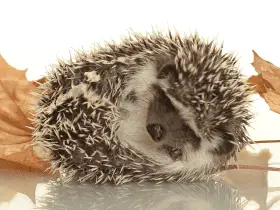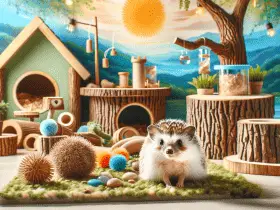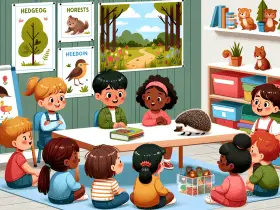Are you curious about the fascinating journey of hedgehog facts from the past to the present?
Delve into the evolution of our understanding as we explore the early mentions of hedgehogs in historical texts, ancient beliefs and superstitions surrounding them, their portrayal in art and literature during the Renaissance, scientific discoveries about their physiology, behavior, habitat and adaptations, as well as modern conservation efforts.
Join us on this informative and insightful exploration of hedgehog knowledge.
Key Takeaways
- Hedgehogs have a long history of cultural significance, associated with protection, wisdom, and divination.
- Hedgehogs have been depicted in art, literature, and scientific discoveries, showcasing their unique physical features and defensive behavior.
- Hedgehogs exhibit complex social behaviors and vocalizations, despite their solitary nature.
- Hedgehogs are highly adaptable creatures with unique adaptations, such as sharp quills and a specialized immune system, and they play a crucial role in maintaining ecosystem balance.
Early Mentions of Hedgehogs in Historical Texts
You’ll be amazed at the early mentions of hedgehogs in historical texts. The presence of hedgehogs in human culture can be traced back to ancient times, where they held various symbolic meanings and played significant roles in folklore.
In early hedgehog symbolism, these creatures were often associated with protection and defense due to their spiky exteriors. They were seen as guardians and were believed to ward off evil spirits and bring good luck. Hedgehogs also appeared in folklore, where they were depicted as wise and cunning creatures. Their ability to roll into a ball was admired and seen as a form of self-defense.
In some cultures, hedgehogs were even thought to possess magical qualities, such as the ability to predict the weather or find hidden treasures. These early mentions of hedgehogs in historical texts highlight the deep-rooted fascination and admiration that humans have had for these unique creatures throughout the ages. Their presence in folklore and symbolism reflects our desire for protection, wisdom, and the mysterious forces of nature.
Ancient Beliefs and Superstitions About Hedgehogs
Discover the intriguing ancient beliefs and superstitions surrounding hedgehogs.
Ancient beliefs about hedgehogs were steeped in folklore, with different cultures attributing various powers and qualities to these spiky creatures.
In ancient Egypt, hedgehogs were seen as protectors against evil spirits and were often depicted on amulets and talismans. They were believed to bring good luck and ward off misfortune.
In Greek mythology, the hedgehog was associated with the goddess Aphrodite and was believed to possess the power of divination. Hedgehogs were also considered to be wise and cunning creatures.
In ancient Rome, hedgehogs were associated with fertility and were believed to have the ability to detect poisonous plants. They were seen as symbols of fertility and abundance.
Hedgehogs were also believed to have healing powers. In medieval times, their spines were used in various medicinal concoctions.
These ancient beliefs and superstitions highlight the deep reverence and fascination that humans have had for hedgehogs throughout history. Their unique appearance and behavior have made them the subject of many tales and legends, continuing to captivate our imaginations to this day.
The Renaissance Period: Hedgehogs in Art and Literature
Immerse yourself in the rich artistic and literary representations of hedgehogs during the Renaissance period.
Hedgehogs were a popular subject in Renaissance artwork, symbolizing various qualities such as vigilance, protection, and transformation. Artists portrayed these spiny creatures in a variety of mediums, including paintings, sculptures, and tapestries. One notable example is Albrecht Dürer’s woodcut print titled ‘The Hedgehog’ (1508), which depicts a hedgehog curled up in self-defense. This artwork not only showcases the artist’s technical skill but also captures the hedgehog’s unique physical features and defensive behavior.
Literary references to hedgehogs during the Renaissance were also abundant. In William Shakespeare’s play ‘A Midsummer Night’s Dream,’ the character Bottom refers to himself as a hedgehog when he says, ‘I am a man as other men are,’ highlighting his transformation into an ass. This allusion to the hedgehog emphasizes the idea of change and transformation, a prevalent theme during the Renaissance.
Additionally, in John Milton’s epic poem ‘Paradise Lost,’ the hedgehog is mentioned in the context of innocence and purity, contrasting with the fallen state of humanity.
The Renaissance period marked a significant time for hedgehogs in both art and literature. Through various artistic mediums and literary references, these spiky creatures became symbols of protection, transformation, and innocence, capturing the imagination of artists and writers during this era.
Scientific Discoveries: Unraveling the Mysteries of Hedgehog Physiology
Take a fascinating journey into the intricate world of hedgehog physiology, where scientific discoveries have shed light on the mysteries surrounding their unique physical characteristics and functions.
Through the study of hedgehog genetics, researchers have unraveled the secrets behind their remarkable physiological adaptations.
One significant scientific discovery is the identification of specific genes responsible for hedgehogs’ quills. These genes play a crucial role in the development and growth of the quills, which serve as their primary defense mechanism. By understanding the genetic basis of quill production, scientists can explore potential applications in medical research, such as tissue regeneration and wound healing.
Another noteworthy finding is the hedgehogs’ ability to curl into a tight ball when threatened. This behavior is made possible by their flexible spines and specialized muscles. Scientists have discovered that these muscles, known as the orbicularis muscles, contract simultaneously to create a protective barrier. Understanding the mechanisms behind this behavior can lead to advancements in robotics and biomimicry, where engineers draw inspiration from nature to design innovative solutions.
Furthermore, researchers have uncovered the hedgehogs’ unique immune system, which allows them to withstand various diseases and parasites. Their immune system produces antimicrobial peptides that help fight off infections. By studying these peptides, scientists hope to develop new antimicrobial therapies that can benefit human health.
Hedgehog Behavior: Insights From Ethological Studies
Get ready to delve into the fascinating world of hedgehog behavior, as ethological studies provide valuable insights into their natural instincts and social interactions. Hedgehogs are known for their solitary nature, but they still engage in various forms of communication with other hedgehogs.
One important aspect of hedgehog communication is vocalization. Hedgehogs make a variety of sounds, including snuffling, hissing, and chirping. These vocalizations serve different purposes, such as expressing aggression, fear, or contentment. By studying these sounds, researchers can gain a better understanding of hedgehog emotions and social dynamics.
In addition to vocalizations, hedgehogs also use body language to communicate. They may raise their quills, puff up their bodies, or curl into a defensive ball to convey their emotions. These postures are often used as a warning to potential predators or as a means of asserting dominance in social interactions.
When it comes to social behavior, hedgehogs are generally solitary animals. They prefer to live alone and only come together for mating purposes. However, some studies have found evidence of social interactions among hedgehogs, suggesting that they may have a more complex social structure than previously believed.
Hedgehog Habitat and Adaptations: Exploring Their Natural Environment
Explore the diverse habitats and unique adaptations of hedgehogs in their natural environment. Hedgehogs are found in a variety of habitats, including woodlands, grasslands, and gardens. They’ve the ability to adapt to different environments, making them highly versatile creatures.
When it comes to their diet, hedgehogs are mainly insectivores. They primarily feed on insects such as beetles, slugs, and worms. However, they’re also known to consume small mammals, birds, and amphibians. This varied diet allows hedgehogs to play a crucial role in controlling the population of certain pests, thus maintaining the balance of the ecosystem.
Hedgehogs have several adaptations that help them survive in their natural environment. One of their most distinctive features is their spiky coat, which acts as a protective armor against predators. Their spines are made of keratin, the same material found in human hair and nails. Hedgehogs also have excellent hearing and sense of smell, which aids them in finding food and avoiding danger.
In addition, hedgehogs are skilled climbers and swimmers. They can navigate through dense vegetation and swim across small bodies of water when necessary. These adaptations allow hedgehogs to explore their environment and find suitable habitats for shelter and nesting.
Modern Conservation Efforts: Protecting Hedgehog Populations
Join the efforts to conserve hedgehog populations by supporting initiatives that focus on habitat preservation and reducing human impact on their environment. Hedgehogs are facing numerous threats to their survival, including habitat loss, urbanization, and road mortality. To ensure their long-term survival, various conservation strategies and habitat restoration projects are being implemented.
Here are some important ways you can contribute to the protection of hedgehog populations:
Promote habitat preservation: Encourage the preservation of natural habitats, such as woodlands, hedgerows, and meadows, which provide essential resources for hedgehogs, including food, shelter, and nesting sites.
Reduce human impact: Minimize the use of pesticides and herbicides in your gardens to protect hedgehogs from harmful chemicals. Additionally, be mindful of your waste disposal to prevent hedgehogs from getting entangled in plastic or consuming harmful substances.
Create hedgehog-friendly gardens: Make your garden hedgehog-friendly by providing access points, such as small gaps in fences, to allow hedgehogs to move freely between gardens. Create hedgehog-friendly features like log piles, leaf piles, and shallow water sources for drinking.
Support local conservation organizations: Donate or volunteer with local conservation organizations that work towards protecting hedgehog populations. These organizations often conduct research, implement conservation projects, and raise awareness about hedgehog conservation.
The Future of Hedgehog Facts: Current Research and Potential Discoveries
You can look forward to exciting new discoveries and advancements in hedgehog research as scientists continue to explore their fascinating world. One area of research that holds great promise is understanding the potential impact of climate change on hedgehog populations. As the Earth’s climate continues to change, hedgehogs may face significant challenges in adapting to new environmental conditions. Scientists are studying how changes in temperature, precipitation patterns, and habitat availability may affect hedgehog populations. By understanding these potential impacts, researchers can develop strategies to mitigate the effects of climate change on hedgehogs and ensure their long-term survival.
Another important area of research is the role of hedgehogs in ecosystem dynamics. Hedgehogs play a vital role in maintaining the balance of ecosystems by controlling insect populations. They’re natural predators of insects such as slugs, beetles, and caterpillars, which can be harmful to plants and crops. By controlling these populations, hedgehogs help to promote biodiversity and support the health of ecosystems. Scientists are studying the interactions between hedgehogs and their prey, as well as the broader ecological effects of hedgehog presence in different habitats. This research can inform conservation efforts and help us better understand the complex dynamics of ecosystems.
Frequently Asked Questions
How Do Hedgehogs Mate and Reproduce?
Hedgehog breeding habits involve intricate mating rituals. Males court females by sniffing and circling them. After successful copulation, gestation lasts around 35 days. The female gives birth to a litter of 1-7 hoglets.
What Are the Different Species of Hedgehogs and Where Are They Found?
There are different species of hedgehogs found in various regions. They have evolved unique physical characteristics and evolutionary adaptations that help them survive in their habitats.
Can Hedgehogs Be Kept as Pets and What Care Do They Require?
Hedgehogs make the most adorable pets! They can be kept in cozy enclosures with hiding spots and tunnels. Feed them a balanced diet of insects, fruits, and vegetables for their optimal health.
Are Hedgehogs Harmful to Humans or Other Animals?
Hedgehog behavior can be harmful to humans and other animals. Their quills are potential dangers, as they can penetrate skin and cause injury. It’s important to handle hedgehogs with care to avoid any accidents.
Are There Any Known Diseases or Health Issues That Affect Hedgehogs?
Okay, so let’s talk about hedgehog health issues. Did you know that there are several common diseases that can affect hedgehogs? Some examples include mites, ringworm, and respiratory infections. It’s important to keep an eye out for these and seek proper treatment if needed.
Conclusion
In conclusion, the evolution of hedgehog facts has been a fascinating journey through history, art, science, and conservation efforts. From early mentions in historical texts to modern research on their behavior and habitat, we’ve gained valuable insights into these unique creatures.
Despite their popularity, some may argue that hedgehogs aren’t a priority for conservation efforts. However, by understanding their importance in the ecosystem and taking steps to protect their populations, we ensure a balanced and diverse natural world for future generations.















Leave a Reply
View Comments